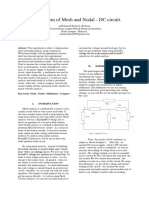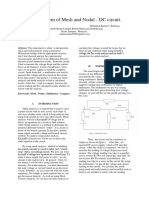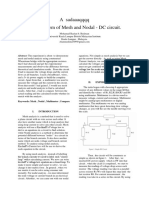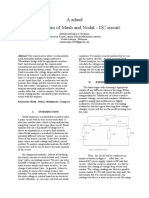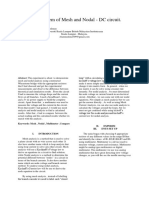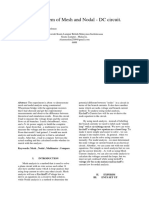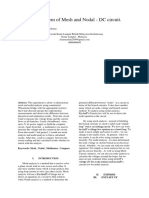The Theorem of Mesh and Nodal - DC Circuit.: Abstract: The Experiment Is About To Demonstrate
The Theorem of Mesh and Nodal - DC Circuit.: Abstract: The Experiment Is About To Demonstrate
Uploaded by
Jerry Arthur MartinezCopyright:
Available Formats
The Theorem of Mesh and Nodal - DC Circuit.: Abstract: The Experiment Is About To Demonstrate
The Theorem of Mesh and Nodal - DC Circuit.: Abstract: The Experiment Is About To Demonstrate
Uploaded by
Jerry Arthur MartinezOriginal Description:
Original Title
Copyright
Available Formats
Share this document
Did you find this document useful?
Is this content inappropriate?
Copyright:
Available Formats
The Theorem of Mesh and Nodal - DC Circuit.: Abstract: The Experiment Is About To Demonstrate
The Theorem of Mesh and Nodal - DC Circuit.: Abstract: The Experiment Is About To Demonstrate
Uploaded by
Jerry Arthur MartinezCopyright:
Available Formats
The Theorem of Mesh and Nodal - DC circuit.
aaMohamad Razlan b. Redzuan
Universiti Kuala Lumpur British Malaysian Institute
Kuala Lumpur , Malaysia.
Alanmuslim2309@gmail.com
Abstract: The experiment is about to demonstrate calculate the voltages around the loops, but we
mesh and nodal analysis using constructed must not get confused while using kichoff’s
Wheatstone bridge with the appropriate resistors voltage law for mesh analysis and kirchoff’s
that I had choosed and get the experimental current law for nodal analysis.
measurements and observe the difference between
theoretical and simulation results . From the circuit
I had to measure the voltage drops and the current
flows at all branches. I used a breadboard , wires , II. EXPERIMENTS SET UP
and a 5v dc power supply to build the complete
circuit. Apart from that , a multimeter was used to The tasks began with choosing 6 appropriate
measure the voltage and the current in the circuit. resistor of any different values in the range KOhm
From that result I had gained , I would use mesh and identify the values of R1,R2,R3,R4,R5 and R6
analysis and nodal analysis to find a calculated using multimeter .Multimeter is a device used to
results. After that , i had to compare between the measure voltage, current and resistance. Multimeter
actual reading and the calculated results whether its might be analog type multimeters or digital
match with the analysis . multimeter. The multimeter we use was analog
multimeter that have great detecting slow voltage
Keywords: Mesh , Nodal , Multimeter ,Compare changes, as you will the see the needle moving over
the scale.
I. INTRODUCTION
Mesh analysis is a method that is used to solve
a plane circuit with no wire across each other .It
also have another name which is loop analysis that
using loop current to solve any other circuit. Mesh
analysis will use a Kirchhoff’s Voltage law to
derive an equations in a circuit to find solution,
while Nodal analysis is a method to determine the
potential different between "nodes" in a circuit in
terms of the branch currents. It also have another
name which are node-voltage and branch current
method. To analyse using nodal analysis,
Kirchoff’s Current law will be use to derive the Then , the circuit will be constructs as
node equation in the circuit. simple as shown in figure 1. After that , we
inserted DC power supply which is 5V into that
By using mesh analysis , instead of labelling
circuit . when the cicuit is completed , we start to
the branch currents we need to label each “closed
measure the reading of voltage drop across each
loop” with a circulating current. We now can write
resistor .The voltage reading was take in a parallel
kirchoff’s voltage law equation in a closed loop. To
across resistor R1.We will repeat this step until the
make it more simple and easier to solve , we can
last resistor R6. For current measurement , the
change it into matrix form . In general , when we
reading was take in a series in this circuit. By using
use matrix it can be solve using creamer rule
the multimeter , we get all the voltage and current
instantly. For nodal analysis , we must determined
reading in this circuit . we calculate the result
the node voltage or current branch in an electrical
using mesh and nodal analysis and recorded each of
circuit. Afterthat , we can came out with our nodal
them to see whether it match with our reading .
equations. Not simple as mesh analysis but we can
get the answer directly . As well as using Mesh
Current Analysis, we can also use node analysis to
III. RESULT IV. CONCLUSION
These were several results based on reading Based on the this experiment , it can be
measurement , mesh analysis and nodal analysis. concluded that both methods are used to find
current or voltage in a particular branch of an
Resistor Resistance Current Voltage electrical circuit , but using nodal analysis we can
1 980Ω 3.1mA 3.0V find easily node voltages thereby by current using
2 320Ω 1.6mA 0.5V node voltage and by using mesh analysis we can
3 970Ω 1.5mA 1.5V find current in a particular branch. Nodal analysis
4 330Ω 1.5mA 0.5V is best suited when there are current sources
5 320Ω 0.01mA 3.2mV whereas mesh analysis is best suited when energy
6 980Ω 1.5mA 1.5V sources are voltage sources rather than current
Table 1: Measured Readings sources. In both the methods needs minimum
number of equations need to be written to know the
unknown quantities.
Mesh Analysis :
5= 2270I1-970I2-320I3 I1=3.068mA Acknowledgment
0= -970I1+2270I2-320I3 I2=1.515mA The authors would like to thank you to all staff and
the others students who had contributed in this
0= -320I1-320I2+970I3 I3=1.524mA study. This project is supported by Prof. Abdul
Halim Ali , lecturer in Unikl British Malaysian
Resistor Resistance Current Voltage Institute.
1 980Ω 3.068mA 3.00V
2 320Ω 1.554mA 0.49V
3 970Ω 1.554mA 1.51V
4 330Ω 1.514mA 0.50V REFERENCES
5 320Ω 0.010mA 3.2mV
(1) Marcelo Godoy Simes; Felix A.
6 980Ω 1.524mA 1.49V
Farret,”analysis of electric circuit with
Table 2: Mesh Results mesh and nodal” 2017.
(2) Electronic Letter ”generalisation of mesh
and nodal analysis” 1969, Volume: 5,
Nodal Anaysis: Issue: 16 Pages: 365 – 366.
(3) I. Dudurytch; V. Gudym, Transactions on
742600Va-323400Vb-313600Vc= 528000 Power System” Mesh-nodal network
analysis” 1999, Volume: 14 Issue: 4Pages:
970Va-2260Vb+970Vc = 0 1375 – 1381.
(4) https://en.wikipedia.org/wiki/Nodal_analy
313600Va+323400Vb-742600Vc = 0 sis
(5) https://en.wikipedia.org/wiki/Mesh_analys
Va = 1.994V is
(6) https://www.coursehero.com/file/7010208
Vb = 1.497V /mesh-and-nodal-analysis/
(7) Robert L. Boylestad ,”Introductory Circuit
Vc = 1.494V
Analysis”, Prentice Hall, 12th Edition,
New York, 2010, ISBN 9780137146666.
Resistor Resistance Current Voltage
1 980Ω 3.068mA 3.00V
2 320Ω 1.553mA 0.50V
3 970Ω 1.525 mA 1.48V
4 330Ω 1.514mA 0.50V
5 320Ω 0.010mA 3.2mV
6 980Ω 1.524mA 1.49V
Table 3: Nodal Results
You might also like
- EE 151 PresentationDocument241 pagesEE 151 PresentationfierykarrNo ratings yet
- Chapter 9 Homework SolutionDocument27 pagesChapter 9 Homework Solutionjoe100% (3)
- Experiment 4 Nodal Analysis and Mesh Analysis Techniques ObjectivesDocument5 pagesExperiment 4 Nodal Analysis and Mesh Analysis Techniques ObjectivesMurad33% (3)
- EEA101L Lab Report - VALENTON-E08Document2 pagesEEA101L Lab Report - VALENTON-E08Jan ValentonNo ratings yet
- The Theorem of Mesh and Nodal - DC Circuit.: Abstract: The Experiment Is About To DemonstrateDocument3 pagesThe Theorem of Mesh and Nodal - DC Circuit.: Abstract: The Experiment Is About To DemonstrateJerry Arthur MartinezNo ratings yet
- The Theorem of Mesh and Nodal - DC Circuit.: Abstract: The Experiment Is About To DemonstrateDocument3 pagesThe Theorem of Mesh and Nodal - DC Circuit.: Abstract: The Experiment Is About To DemonstrateJerry Arthur MartinezNo ratings yet
- The Theorem of Mesh and Nodal - DC Circuit.: Abstract: The Experiment Is About To DemonstrateDocument3 pagesThe Theorem of Mesh and Nodal - DC Circuit.: Abstract: The Experiment Is About To DemonstrateJerry Arthur MartinezNo ratings yet
- The Theorem of Mesh and Nodal - DC Circuit.: Abstract: The Experiment Is About To DemonstrateDocument3 pagesThe Theorem of Mesh and Nodal - DC Circuit.: Abstract: The Experiment Is About To DemonstrateJerry Arthur MartinezNo ratings yet
- The Theorem of Mesh and Nodal - DC Circuit.: Abstract: The Experiment Is About To DemonstrateDocument3 pagesThe Theorem of Mesh and Nodal - DC Circuit.: Abstract: The Experiment Is About To DemonstrateJerry Arthur MartinezNo ratings yet
- Am of Ah and Nodal - DC CircuiDocument3 pagesAm of Ah and Nodal - DC CircuiJerry Arthur MartinezNo ratings yet
- The Theorem of Mesh and Nodal - DC CircuiDocument3 pagesThe Theorem of Mesh and Nodal - DC CircuiJerry Arthur MartinezNo ratings yet
- The Theorem of Mesh and Nodal - DC Circuit.: Abstract: The Experiment Is About To DemonstrateDocument3 pagesThe Theorem of Mesh and Nodal - DC Circuit.: Abstract: The Experiment Is About To DemonstrateHASHIM ADELNo ratings yet
- Sa WDW Adwaw The Theorem of Mesh and Nodal - DC Circuit.: Abstract: The Experiment Is About To DemonstrateDocument3 pagesSa WDW Adwaw The Theorem of Mesh and Nodal - DC Circuit.: Abstract: The Experiment Is About To DemonstrateJerry Arthur MartinezNo ratings yet
- A Sadaaa The Theorem of Mesh and Nodal - DC Circuit.: Abstract: The Experiment Is About To DemonstrateDocument3 pagesA Sadaaa The Theorem of Mesh and Nodal - DC Circuit.: Abstract: The Experiment Is About To DemonstrateJerry Arthur MartinezNo ratings yet
- The Theorem Wa Nodal - DC CircuiDocument3 pagesThe Theorem Wa Nodal - DC CircuiJerry Arthur MartinezNo ratings yet
- The Thea Mesh and Nodal - DC CircuiDocument3 pagesThe Thea Mesh and Nodal - DC CircuiJerry Arthur MartinezNo ratings yet
- Sa Wdwaaaa Adwaw The Theorem of Mesh and Nodal - DC CircuitDocument3 pagesSa Wdwaaaa Adwaw The Theorem of Mesh and Nodal - DC CircuitJerry Arthur MartinezNo ratings yet
- A Sad The Theorem of Mesh and Nodal - DC Circuit.: Abstract: The Experiment Is About To DemonstrateDocument3 pagesA Sad The Theorem of Mesh and Nodal - DC Circuit.: Abstract: The Experiment Is About To DemonstrateJerry Arthur MartinezNo ratings yet
- A The Theorem of Mesh and Nodal - DC Circuit.: Abstract: The Experiment Is About To DemonstrateDocument3 pagesA The Theorem of Mesh and Nodal - DC Circuit.: Abstract: The Experiment Is About To DemonstrateJerry Arthur MartinezNo ratings yet
- A Adasd The Theorem of Mesh and Nodal - DC Circuit.: Abstract: The Experiment Is About To DemonstrateDocument3 pagesA Adasd The Theorem of Mesh and Nodal - DC Circuit.: Abstract: The Experiment Is About To DemonstrateJerry Arthur MartinezNo ratings yet
- The Theorem of Mesh and Nodal - DC CircuiDocument3 pagesThe Theorem of Mesh and Nodal - DC CircuiJerry Arthur MartinezNo ratings yet
- The Theorem of Mesh and Nodal - DC CircuiDocument3 pagesThe Theorem of Mesh and Nodal - DC CircuiJerry Arthur MartinezNo ratings yet
- The Theorem of Mesh and Nodal - DC Circuit.: Abstract: The Experiment Is About To DemonstrateDocument2 pagesThe Theorem of Mesh and Nodal - DC Circuit.: Abstract: The Experiment Is About To DemonstrateJerry Arthur MartinezNo ratings yet
- The Theorem of Mesh and Nodal - DC CircuiDocument3 pagesThe Theorem of Mesh and Nodal - DC CircuiJerry Arthur MartinezNo ratings yet
- The Theorem of Mesh and Nodal - DC CircuiDocument3 pagesThe Theorem of Mesh and Nodal - DC CircuiJerry Arthur MartinezNo ratings yet
- The Theorem of Mesh and Nodal - DC CircuiDocument3 pagesThe Theorem of Mesh and Nodal - DC CircuiJerry Arthur MartinezNo ratings yet
- The D: Abstract: The Experiment Is About To DemonstrateDocument3 pagesThe D: Abstract: The Experiment Is About To DemonstrateJerry Arthur MartinezNo ratings yet
- The Theorem of Mesh Anawc CircuiDocument3 pagesThe Theorem of Mesh Anawc CircuiJerry Arthur MartinezNo ratings yet
- The Theorem of Mesh and Nodal - DC CircuiDocument3 pagesThe Theorem of Mesh and Nodal - DC CircuiJerry Arthur MartinezNo ratings yet
- The Theorem of Mesh andDocument3 pagesThe Theorem of Mesh andJerry Arthur MartinezNo ratings yet
- The Tha and Nodal - DC CircuiDocument3 pagesThe Tha and Nodal - DC CircuiJerry Arthur MartinezNo ratings yet
- Ah and Nodal - DC CircuiDocument3 pagesAh and Nodal - DC CircuiJerry Arthur MartinezNo ratings yet
- Weqsh and Nodal - DC CircuiDocument3 pagesWeqsh and Nodal - DC CircuiJerry Arthur MartinezNo ratings yet
- Abstract: The Experiment Is About To Demonstrate: Resistor Resistance Current VoltageDocument2 pagesAbstract: The Experiment Is About To Demonstrate: Resistor Resistance Current VoltageJerry Arthur MartinezNo ratings yet
- Node Analysis: Arceta Torres Fernando Pazarán Rodríguez Samy Zabdiel Urquiza López Carlos AriadDocument7 pagesNode Analysis: Arceta Torres Fernando Pazarán Rodríguez Samy Zabdiel Urquiza López Carlos AriadYo TuNo ratings yet
- The Theorem of Mesh and Nodal - DC CircuiDocument3 pagesThe Theorem of Mesh and Nodal - DC CircuiJerry Arthur MartinezNo ratings yet
- EEA101L Lab Report - VALENTON-E08Document2 pagesEEA101L Lab Report - VALENTON-E08Jan ValentonNo ratings yet
- Waddh and Nodal - DC CircuiDocument2 pagesWaddh and Nodal - DC CircuiJerry Arthur MartinezNo ratings yet
- Naveen Lab 8ECaDocument10 pagesNaveen Lab 8ECaMuhammad HamzaNo ratings yet
- Week 6Document38 pagesWeek 6IGIHOZO HeritierNo ratings yet
- Mapúa University: Mesh Analysis and Nodal AnalysisDocument9 pagesMapúa University: Mesh Analysis and Nodal AnalysisAndreNo ratings yet
- Bee Report1Document5 pagesBee Report1Rajeev kumarNo ratings yet
- Nodal AnalysisDocument6 pagesNodal AnalysisJerome BricenioNo ratings yet
- Electrical Science: Lecture-5: Topic-Nodal and Mesh AnalysisDocument13 pagesElectrical Science: Lecture-5: Topic-Nodal and Mesh Analysisi_khandelwalNo ratings yet
- Nodal's and Maxwell's Theorem Anore, James IvanDocument16 pagesNodal's and Maxwell's Theorem Anore, James IvanMeiko AbrinaNo ratings yet
- National Polytechnic Institute: Fundamental Analysis of CircuitsDocument9 pagesNational Polytechnic Institute: Fundamental Analysis of CircuitsMaxemiliano VtechNo ratings yet
- ExpDocument5 pagesExpairaNo ratings yet
- 8-Lab 08 To Verify Mesh Analysis For DC Circuits Both On Hardware and SoftwareDocument10 pages8-Lab 08 To Verify Mesh Analysis For DC Circuits Both On Hardware and Softwareahmednoonari36No ratings yet
- Module6 - Maxwell Mesh Current and Nodal AnalysisDocument31 pagesModule6 - Maxwell Mesh Current and Nodal AnalysisLady Napisah Tanandato BantogNo ratings yet
- E104-Mesh Analysis and Nodal AnalysisDocument11 pagesE104-Mesh Analysis and Nodal AnalysisjoebreakerNo ratings yet
- SUPERNODE Circuit Analysis (@B)Document5 pagesSUPERNODE Circuit Analysis (@B)shivamNo ratings yet
- DC Lab Exp 5 Study of Mesh Analysis and Nodal AnalysisDocument10 pagesDC Lab Exp 5 Study of Mesh Analysis and Nodal Analysisbirhosen92No ratings yet
- Act 5 Matter and EnergyDocument8 pagesAct 5 Matter and EnergyhelpmehelpgodNo ratings yet
- Electric Circuit and Electronics NoteDocument34 pagesElectric Circuit and Electronics NoteEzekiel JamesNo ratings yet
- Day 6 Notes Mesh AnalysisDocument11 pagesDay 6 Notes Mesh AnalysisSwaroop RamaswamyNo ratings yet
- LMH Chapter2-Part1Document77 pagesLMH Chapter2-Part1Nguyen Son N NguyenNo ratings yet
- Experiment 05 Superposition Theorem: Course Learning Outcomes (Clos)Document5 pagesExperiment 05 Superposition Theorem: Course Learning Outcomes (Clos)kriezltobias4No ratings yet
- Experiment No. 9 1Document14 pagesExperiment No. 9 1Kent Gerard SolanoNo ratings yet
- Day 6 Notes MESH ANALYSISDocument11 pagesDay 6 Notes MESH ANALYSISturzo_eeeNo ratings yet
- STEM: Science, Technology, Engineering and Maths Principles Teachers Pack V10From EverandSTEM: Science, Technology, Engineering and Maths Principles Teachers Pack V10No ratings yet
- Pointers Chapter Practice Section: Wadsfsaaawaaadsss AwdwadaDocument30 pagesPointers Chapter Practice Section: Wadsfsaaawaaadsss AwdwadaJerry Arthur MartinezNo ratings yet
- Waddh and Nodal - DC CircuiDocument2 pagesWaddh and Nodal - DC CircuiJerry Arthur MartinezNo ratings yet
- Abstract: The Experiment Is About To Demonstrate: Resistor Resistance Current VoltageDocument2 pagesAbstract: The Experiment Is About To Demonstrate: Resistor Resistance Current VoltageJerry Arthur MartinezNo ratings yet
- The Theorem of Mesh and Nodal - DC CircuiDocument3 pagesThe Theorem of Mesh and Nodal - DC CircuiJerry Arthur MartinezNo ratings yet
- Weqsh and Nodal - DC CircuiDocument3 pagesWeqsh and Nodal - DC CircuiJerry Arthur MartinezNo ratings yet
- The Theorem of Mesh and Nodal - DC CircuiDocument3 pagesThe Theorem of Mesh and Nodal - DC CircuiJerry Arthur MartinezNo ratings yet
- Circuits ReportDocument2 pagesCircuits ReportJerry Arthur MartinezNo ratings yet
- Ah and Nodal - DC CircuiDocument3 pagesAh and Nodal - DC CircuiJerry Arthur MartinezNo ratings yet
- The Tha and Nodal - DC CircuiDocument3 pagesThe Tha and Nodal - DC CircuiJerry Arthur MartinezNo ratings yet
- The Theorem of Mesh and Nodal - DC CircuiDocument3 pagesThe Theorem of Mesh and Nodal - DC CircuiJerry Arthur MartinezNo ratings yet
- The Theorem of Mesh Anawc CircuiDocument3 pagesThe Theorem of Mesh Anawc CircuiJerry Arthur MartinezNo ratings yet
- The Theorem of Mesh and Nodal - DC CircuiDocument3 pagesThe Theorem of Mesh and Nodal - DC CircuiJerry Arthur MartinezNo ratings yet
- The Theorem of Mesh andDocument3 pagesThe Theorem of Mesh andJerry Arthur MartinezNo ratings yet
- The D: Abstract: The Experiment Is About To DemonstrateDocument3 pagesThe D: Abstract: The Experiment Is About To DemonstrateJerry Arthur MartinezNo ratings yet
- The Theorem of Mesh and Nodal - DC CircuiDocument3 pagesThe Theorem of Mesh and Nodal - DC CircuiJerry Arthur MartinezNo ratings yet
- The Theorem of Mesh and Nodal - DC CircuiDocument3 pagesThe Theorem of Mesh and Nodal - DC CircuiJerry Arthur MartinezNo ratings yet
- The Theorem of Mesh and Nodal - DC CircuiDocument3 pagesThe Theorem of Mesh and Nodal - DC CircuiJerry Arthur MartinezNo ratings yet
- The Theorem of Mesh and Nodal - DC CircuiDocument3 pagesThe Theorem of Mesh and Nodal - DC CircuiJerry Arthur MartinezNo ratings yet
- Sa Wdwaaaa Adwaw The Theorem of Mesh and Nodal - DC CircuitDocument3 pagesSa Wdwaaaa Adwaw The Theorem of Mesh and Nodal - DC CircuitJerry Arthur MartinezNo ratings yet
- Sa WDW Adwaw The Theorem of Mesh and Nodal - DC Circuit.: Abstract: The Experiment Is About To DemonstrateDocument3 pagesSa WDW Adwaw The Theorem of Mesh and Nodal - DC Circuit.: Abstract: The Experiment Is About To DemonstrateJerry Arthur MartinezNo ratings yet
- Am of Ah and Nodal - DC CircuiDocument3 pagesAm of Ah and Nodal - DC CircuiJerry Arthur MartinezNo ratings yet
- A Sadaaa The Theorem of Mesh and Nodal - DC Circuit.: Abstract: The Experiment Is About To DemonstrateDocument3 pagesA Sadaaa The Theorem of Mesh and Nodal - DC Circuit.: Abstract: The Experiment Is About To DemonstrateJerry Arthur MartinezNo ratings yet
- The Theorem Wa Nodal - DC CircuiDocument3 pagesThe Theorem Wa Nodal - DC CircuiJerry Arthur MartinezNo ratings yet
- The Thea Mesh and Nodal - DC CircuiDocument3 pagesThe Thea Mesh and Nodal - DC CircuiJerry Arthur MartinezNo ratings yet
- A Sad The Theorem of Mesh and Nodal - DC Circuit.: Abstract: The Experiment Is About To DemonstrateDocument3 pagesA Sad The Theorem of Mesh and Nodal - DC Circuit.: Abstract: The Experiment Is About To DemonstrateJerry Arthur MartinezNo ratings yet
- A Adasd The Theorem of Mesh and Nodal - DC Circuit.: Abstract: The Experiment Is About To DemonstrateDocument3 pagesA Adasd The Theorem of Mesh and Nodal - DC Circuit.: Abstract: The Experiment Is About To DemonstrateJerry Arthur MartinezNo ratings yet
- Electrical EngineeringDocument97 pagesElectrical Engineeringking7786No ratings yet
- Electric Circuit Variables 1.1 SI/SI Derived Units/PrefixesDocument19 pagesElectric Circuit Variables 1.1 SI/SI Derived Units/PrefixesJosh PhamNo ratings yet
- TEKNOLOGI ELEKTRIK 1 - VoltageDocument10 pagesTEKNOLOGI ELEKTRIK 1 - Voltagehazreen othman100% (1)
- NETWORK ANALYSIS Chap.2 NETWORK THEOREMS PDFDocument40 pagesNETWORK ANALYSIS Chap.2 NETWORK THEOREMS PDFYãßwäñth BáñdârüNo ratings yet
- Lecture05-06 - Network TheoremsDocument74 pagesLecture05-06 - Network TheoremsCarl PNo ratings yet
- Electronis Formula Book (ErForum)Document82 pagesElectronis Formula Book (ErForum)Sauvik ChakrabortyNo ratings yet
- Chapter 2 DC CircuitsDocument22 pagesChapter 2 DC CircuitsSolomon AsefaNo ratings yet
- The Polarity of Voltage Drop Along The Current Direction Is To Be Marked As PositiveDocument5 pagesThe Polarity of Voltage Drop Along The Current Direction Is To Be Marked As PositivesurajNo ratings yet
- Circuit Theory Question Bank, 2 Marks With AnswersDocument0 pagesCircuit Theory Question Bank, 2 Marks With Answersaishuvc1822No ratings yet
- Direct Current (DC) CircuitsDocument11 pagesDirect Current (DC) CircuitsLim JiaShinNo ratings yet
- 1P2 Circuit Analysis I Notes Moore PDFDocument68 pages1P2 Circuit Analysis I Notes Moore PDFTeddyNo ratings yet
- EE115 - Linear Circuit Analysis (2017 SP) - Course OutlineDocument2 pagesEE115 - Linear Circuit Analysis (2017 SP) - Course OutlineHaris -0% (1)
- Problems in Electrostatics, Current ElectricityDocument14 pagesProblems in Electrostatics, Current ElectricityThayumanavar SachithananthamNo ratings yet
- LabReport Total PDFDocument42 pagesLabReport Total PDFKhông Có TênNo ratings yet
- 201 EE1029 Midterm - Group1Document4 pages201 EE1029 Midterm - Group1Thao Vo VanNo ratings yet
- KVL and KCLDocument14 pagesKVL and KCLBulli Koteswararao100% (1)
- Unit 1 UpdatedDocument29 pagesUnit 1 UpdatedAmit TripathiNo ratings yet
- ElectricCircuitsbyNoelM - morrisandFrankW.senior 1Document379 pagesElectricCircuitsbyNoelM - morrisandFrankW.senior 1Fabian Marian RaduNo ratings yet
- Electrical Engineering (UEE001) : Dr. S. K. AggarwalDocument33 pagesElectrical Engineering (UEE001) : Dr. S. K. AggarwalKamal Jit DhimanNo ratings yet
- Kirchhoff's Laws: Experiment No.3 Aim of Experiment ApparatusDocument4 pagesKirchhoff's Laws: Experiment No.3 Aim of Experiment Apparatusfatima qasimNo ratings yet
- Payabyab, WI - Basic EE and ECE - PSET 1Document11 pagesPayabyab, WI - Basic EE and ECE - PSET 1Wingel LullabyNo ratings yet
- Mesh and SupermeshDocument16 pagesMesh and SupermeshTyspoNo ratings yet
- ENA Lab ManualDocument85 pagesENA Lab ManualM. Ahmad Raza50% (2)
- Methods of AnalysisDocument8 pagesMethods of Analysisj.gibson004567No ratings yet
- Lecture 1Document49 pagesLecture 1quteba usamaNo ratings yet
- Chapter 2 Basic LawsDocument15 pagesChapter 2 Basic LawsChristian Muli0% (1)
- 3.6. Thevenin and Norton Equivalent CircuitsDocument20 pages3.6. Thevenin and Norton Equivalent CircuitsShanNo ratings yet





